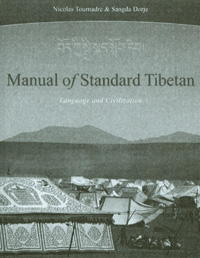
One of the first Americans to study Tibetan Buddhism in Dharamsala is said to have astonished his teachers by learning Tibetan in ten weeks. Most of us can expect to take considerably longer. To read classical texts or engage in dharma debate you’ll need to learn classical, or literary, Tibetan, but if your goal is to order momos (Tibetan dumplings) and butter tea and schmooze with the locals, you can delve into Manual of Standard Tibetan: Language and Civilization (Snow Lion, 2003, $80 paper, with two CDs), a first-rate intensive course put together by Nicolas Tournadre, a linguist at the Sorbonne, and Sangda Dorje of the University of Tibet in Lhasa. The 565-page guide with accompanying audio will immerse you in the language and culture of modern-day Tibetans in Lhasa or in exile. (There’s also an appendix with literary Tibetan for when you’re ready to take on your lama.)

With thirty consonants, a host of syntactical and semantic quirks, and a script written with no breaks between words, Tibetan can pose a challenge. Happily, Tournadre and Dorje take a user-friendly approach that will be familiar to anyone who’s tackled a Berlitz-type language intensive: grammar and vocabulary are taught through dialogues and vignettes simulating real-life situations. Working your way through all forty-one lessons will equip you to make friends, buy dinner, use the phone, go to a football game, get your car fixed, consult a doctor, attend Buddhist festivals, and more. You’ll pick up useful phrases like “This is hot,” “Tshering has a car,” “That’s the shrine room,” “They don’t like the way you talk,” “What a drag!” “I’m not mad,” and “Could you look in the fridge to see if there’s any orange juice?”
But just when you start thinking that daily life in Lhasa doesn’t seem so different from life in Los Angeles, you’ll encounter an exchange like the following:
Panjor: Oh! Lobzang, you haven’t been around recently. Where did you go?
Lobzang: I went to the Chushur harvest festival.
Panjor: Apparently they walk around the fields carrying religious books on their backs. Is that true?
Lobzang: Yes, they bring (lit. invite) a lot of supporters of [the Buddha’s] body, speech, and mind and circumambulate the cultivated area.
And then there’s the chapter in which two Lhasans visiting a popular picnic spot near the River of Happiness express regret they didn’t pack something to eat. The text cites a Tibetan proverb that puts the problem in perspective: “On the other side of the hill there’s no yak dung; on this side, there’s no basket.”
For sure, this isn’t southern California.